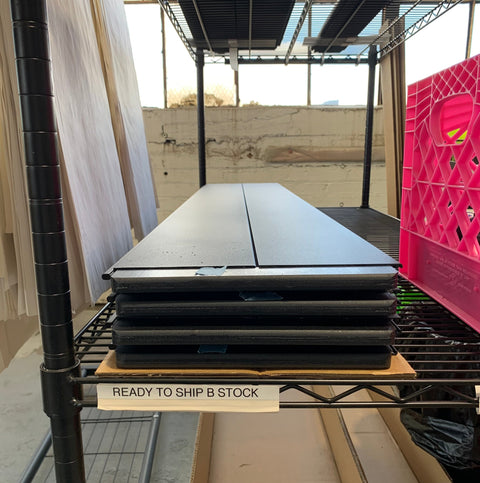“You can’t build something better without breaking a few things first.”
That’s not a motto, it’s just what happens when your product line lives one step away from "garage science." We don’t prototype with polished pitch decks or whiteboards. We use the back table in our Akron shop, a lot of leftover UHMW, and whatever random bracket Bill printed the night before.
This blog’s about what happens before the product pages go live: the experiments, failures, “oops, that’s smoking” moments, and the parts that wind up as B-Stock instead of scrap.
1. How Experiments Actually Happen in the Shop
There’s no formal process.
Sometimes it's a forum post. Sometimes it’s someone in the shop asking, “What if we just bolted this to that?” Then someone does. Then someone regrets it. And occasionally — occasionally — something useful emerges.
A lot of our best ideas started with leftover parts and a plan with no clear path. The original tunnel tray? Bill mocked that up a second-hand ladder. The risers? They came from a conversation about where to store your umbrella. The strap upgrade began life as a quick comment about “tonneau quick release mode.”
The common thread? Testing on real trucks. Usually ours. Usually in the rain.
Shop experiments happen in motion while we’re fulfilling orders, answering emails, or helping someone troubleshoot a DIY issue. That’s part of why they work. The best tests happen when you’re not trying to impress anyone, and are just trying to solve something annoying.
2. How We Stress-Test Tonneau Covers (and Other Gear)
Every Interrobang tonneau panel gets handled, tested, and hand-checked before it ships, and we’ve bent more than a few in the process. At first we didn’t have an idea of what our paneling could handle, so we sacrificed multiple panels in the name of science.
We’ve stacked bowling balls on them. We’ve stood on them. Jumped on them. Driven over one with a pallet jack once (accidentally …sort of). We’ve left them outside in snow, direct sun, lake spray, and one weird weekend involving a campsite and a waffle iron.
What are we looking for? Flex under load. Coating wear. Warp resistance. Whether a panel still nests after heat and pressure. Whether the straps behave after 400 cycles. All the stuff you don’t want to find out the hard way; we try to find out the hard way first.
Sometimes a panel holds up but comes back with a small defect: powder coat marred by a clamp, a corner that didn’t sit right on the rack, a microscopic bend we caught on final check. That’s when it heads to the B-Stock pile. Not junk. Not flawed in function. Just not good enough for the A-line.
3. What “B-Stock” Means, and Why It Exists
When a tonneau panel doesn’t make the cut, we don’t toss it. We grade it.
B-Stock is our internal label for parts that function perfectly but didn’t pass visual inspection. That could mean a cosmetic scratch, a powder-coat inconsistency, or a paint mark that showed up a little more than it should’ve. Structurally sound. Just not pretty enough to wear the full Interrobang badge.
Think of it like this: it’s the same gear, same design, same function, just with a little shop floor patina baked in.
And here’s why we stand behind it:
- Waste sucks. It’s bad for the planet, bad for the shop, and bad for anyone who’s ever paid for powder coating twice.
- Most people don’t care. Especially our customers, who are usually sliding this gear into trucks that get used, not photographed for launch day. A slight imperfection on the inside of a panel isn’t going to wreck anyone’s install.
- It keeps prices accessible. B-Stock gives people a way into our gear at a lower price, without compromising on function. That’s a win for budget-conscious tinkerers.
We inspect every B-Stock item before it’s listed. If we wouldn’t use it ourselves, we don’t sell it. If it’s got a story behind it (and most do), we’ll probably share that, too.
Wrapping Up
If you’re ever wondering what our shop is like, just know:
- It smells like aluminum dust and coffee.
- It sounds like impact drivers and excellent music.
- And there’s probably a prototype on the table that’s two zip ties away from being useful.
That’s the good stuff. That’s the garage.



Comments (0)
There are no comments for this article. Be the first one to leave a message!